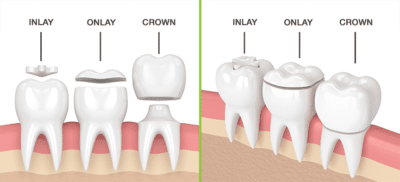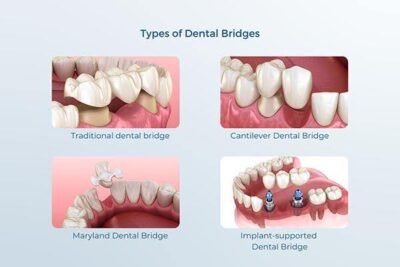Crowns & Bridges
Crowns
A dental crown is a cap or covering that is placed over a damaged or weakened tooth to restore its shape, size, strength, and appearance. Crowns are often used when a tooth is severely decayed, cracked, or has had a root canal treatment. They encase the tooth completely, offering extra protection and improving its functionality.

Crowns come in various forms, including full crowns, 3/4 crowns, onlays, inlays, post crowns, or implant-retained crowns. They can be crafted from different materials such as porcelain, zirconia, gold, or sometimes a combination of these.
A crown might be the best option in the following situations:
- When a tooth has lost a cusp (corner)
- When a tooth has a large filling (half to two-thirds of the biting surface)
- When a tooth has significant cracks (visible on our intra-oral camera)
- When tooth decay has weakened the tooth
- When a tooth shows excessive wear
For a crown to stay in place, there needs to be enough healthy tooth structure. In some cases, if a tooth is cracked or decayed beyond repair, it may need to be extracted.
Preparing the tooth for a crown requires a high level of skill, experience, and judgment. Therefore, we dedicate 1.5hrs to our initial preparation appointment. The second appointment to fit the crown generally takes 30-45mins.

Bridges
A dental bridge is used to replace one or more missing teeth. It consists of one or more artificial teeth (pontics) that are anchored to adjacent natural teeth or dental implants, filling the gap left by the missing tooth.
Dental Bridges come in various types:
Types of Bridges
- Traditional Dental Bridges: Made up of a false tooth held in place by crowns on the neighbouring teeth.
- Cantilever Dental Bridges: Used when there is only one neighbouring tooth to support the bridge.
- Maryland Dental Bridges: These are made of a false tooth with metal or porcelain wings that are bonded to the back of the adjacent teeth.
- Implant-Supported Dental Bridges: These use dental implants to hold the bridge in place, ideal for replacing multiple missing teeth

A bridge might be the best option in the following situations:
- To replace one or more missing teeth.
- To restore the ability to chew and speak properly.
- To maintain the alignment of your natural teeth by preventing them from shifting into the gap left by the missing tooth.
- To enhance the appearance of your smile.
The type of bridge required will be recommended by your dentist upon assessment.
Frequently Asked Questions
Is it Painful?
The process of getting a crown, whether lab-made or in-house milled, is generally not painful, though some discomfort or sensitivity may be experienced. During the appointment, we use local anaethetic to numb the area and keep you as comfortable as possible during the process. Following the procedure, you may experience some mild sensitivity and temporary discomfort. We recommend pain relief to manage any of these expected symptoms. You will also need to avoid certain foods that may dislodge the temporary crown (anything sticky or extremely hard). We generally recommend eating on the other side.
Overall, the procedure is not considered painful, and most people feel comfortable throughout the process. If you have concerns about pain or sensitivity, be sure to discuss them with your dentist before the procedure.
How Long Do Crowns and Bridges Last?
The lifespan of a crown/ bridge depends on several factors: how well you maintain it, the extent of decay or cracks before capping, whether you clench or grind your teeth, the health of your gums, and of course, the quality of the crown itself.
On average, studies show a lifespan of 10 to 15 years. Some may fail sooner, while others can last indefinitely with proper care. The sooner the issue is addressed, the better the chance for a longer-lasting treatment.
In-house vs. Laboratory Made
In-house milled crowns/ bridges are created directly in the dental office using a scanner and a milling machine.
The dentist uses a digital scanner to take an impression of the tooth. This is uploaded to a software that sends the design to the milling machine. The milling machine carves the crown/bridge out of a material block (generally porcelain or Zirconia). Once completed, the crown/ bridge is cemented in place. This offers same-day service and an immediate precise result. While this is a good option, the materials available are limited (the machines cannot use metal blocks, gold etc) and the level of aesthetic customisation may be more limited compared to lab-made, especially for complex cases. Teeth naturally have stains/ shapes that are difficult to achieve by a milling machine.
At West End Dental, all of our crowns and bridges are made by one of our trusted laboratories.
We find that lab made crowns offer a wider range of materials and are put through an intricate quality control process to ensure the best result possible.
Lab-made crowns/bridges are created in a specialised dental laboratory, typically outside the dental office.
The dentist will take a highly accurate impression and send this to the lab of choice. Skilled dental technicians in the lab use materials like porcelain, zirconia, and metal to fabricate the crown based on the model. This process can take up to a week.
Once the crown/bridge is completed, it is mailed back to the dentist for fitting. The dental technicians can create highly aesthetic work with more customisation, especially for challenging cases.
We generally allow 2.5 weeks between visits to allow enough time for postage. In the meantime, you will have a temporary crown covering the tooth to protect it.
All our crowns and bridges are proudly made in Australia by highly skilled lab technicians.


